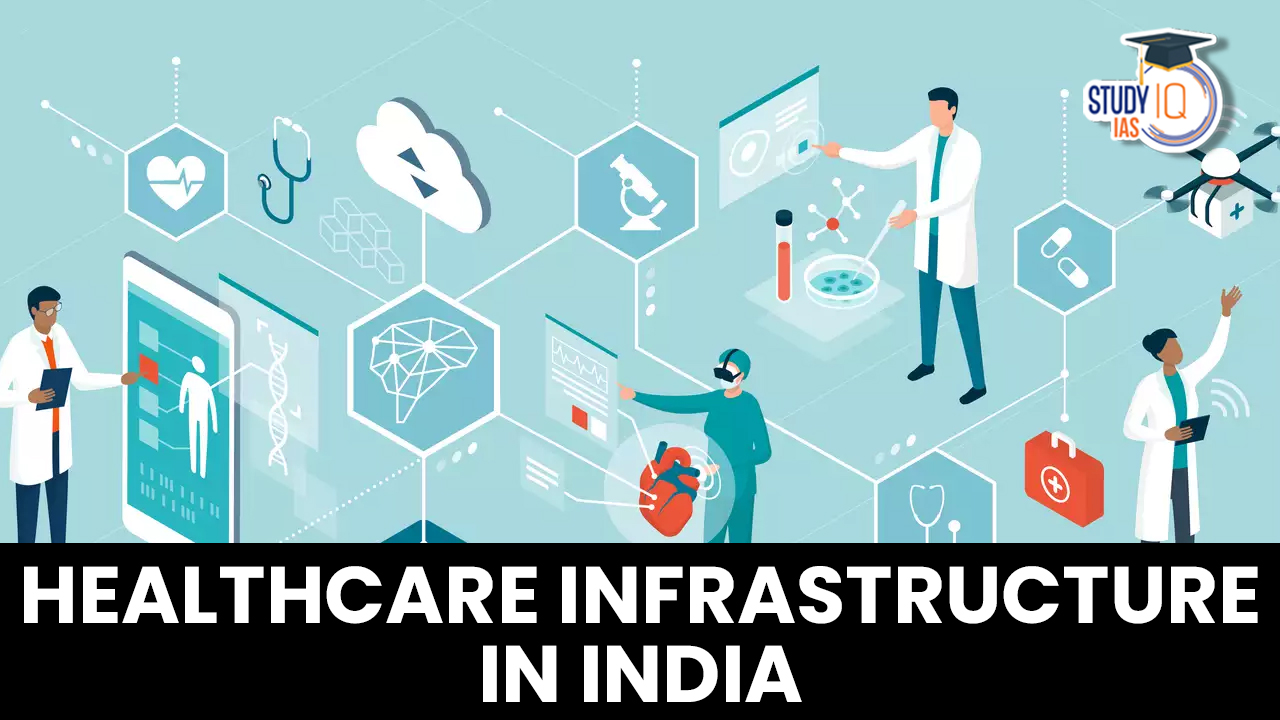Table of Contents
Healthcare Infrastructure in India
- Health infrastructure is an important indicator for understanding the healthcare delivery provisions and welfare mechanisms in a country.
- Public health infrastructure has been referred to as ‘the nerve center of the public health system’.
- Article 47 of the Constitution of India mandates improvement in public health, thus the government is required to take all measures for this purpose.

Read about: Pradhan Mantri Jeevan Jyoti Bima Yojana
Healthcare Infrastructure in India: Important Facts
The National Medical Commission (NMC)’s evaluation of several medical colleges has revealed inadequate faculty and several colleges failing to meet the 50% attendance requirement, highlighting the dismal state of India’s healthcare infrastructure.
- An assessment of 246 medical colleges was carried out by the Undergraduate Medical Education Board (UGMEB) of the National Medical Commission (NMC).
- The NMC’s evaluation revealed that all colleges had a 100 per cent failure rate regarding faculty and senior resident doctors’ attendance, as required by the Minimum Standard Requirement (MSR) 2020.
- Many colleges either had “ghost faculty” or had not employed the necessary faculty at all.
- 134 colleges had emergency medicine departments “on paper”, but the ground reality was different.
- None of the institutes inspected by the NMC had students visiting the emergency department regularly.
Health Sector in India Before COVID-19 and After COVID-19
| Aspect | Before COVID-19 | After COVID-19 |
| Healthcare Infrastructure | Strained due to the vast population and limited resources | Exposed gaps and limitations, especially during the second wave |
| Healthcare Disparities | Disparities in access between urban and rural areas | Highlighted healthcare access gaps, with rural areas suffering more |
| Role of Private Healthcare Providers | Significant role, often at a higher cost | Played a role, but the challenges led to discussions about healthcare costs |
| Routine Healthcare Services | Stretched thin, including immunization and disease treatment | Severely disrupted, affecting the treatment of non-COVID-19 diseases |
| Public Health System | Faced challenges in efficient healthcare management | Emphasized the need for a stronger public health system |
| Access to Essential Resources | Concerns about access to medicines, oxygen, and critical care | Exposed significant gaps, especially in rural healthcare access |
| Impact on Economic Activities | The initial lockdown caused economic hardships | Economic hardships continued, especially during Covid. |
Healthcare Industry in India
Indian public health system has a three-tier system of healthcare services:
| Health Sector Services | Details |
| Primary Health Services | It focuses on the initial diagnosis of disease or ill health, and deterrence of illness. It is the first level of interaction between the healthcare providers and the population. E.g., Sub Centres (SCs) and Primary Health Centres (PHCs). |
| Secondary health care | It is at an intermediate level of health care which comprises diagnosis and treatment, accomplished in a hospital with particular tools and laboratory facilities. The secondary health care structure exists at the Community Health Centres (CHCs), urban hospitals and district hospitals. |
| Tertiary Health Services | Tertiary Health care services refer to the third level of the health system which is mostly focused and advice-giving care is being provided frequently on recommendation from primary and secondary medicinal care. Tertiary care is available mostly in Medical College Hospitals super-speciality hospitals and rehabilitation centres. These are found mainly in state capitals and other Bigger cities. |
Public Health Sector Infrastructure
The first National Health Policy (NHP) in 1983 adopts a holistic (Primary health care) approach to ensure health for all through the provisioning of Sub Centres (SCs), Primary Health Centres (PHCs), Community Health Centres (CHCs), district/civil hospitals and medical institutions.

Current Status of Healthcare Infrastructure in India
To understand the Healthcare Infrastructure in India indicators, it can be subdivided into three categories
| Category | Details | ||||||||||||
| Education Infrastructure |
|
||||||||||||
| Service Infrastructure |
|
||||||||||||
| Clinical Establishments | As of 14.02.2020, 25024 Clinical establishments have been registered online and 2130 registered offline. | ||||||||||||
Health Infrastructure in India State wise
Niti Aayog’s fourth Health Index ranked Indian states and union territories based on their overall health performance in the reference year 2019-20.
- Kerala secured the top spot among larger states, while Uttar Pradesh ranked lowest.
- Among smaller states, Mizoram excelled, with Nagaland at the bottom.
- In the union territories category, Chandigarh claimed the highest position, followed by Dadra Nagar Haveli and Delhi. Puducherry was the poorest performer.
- The Health index, comprising 24 health performance indicators, reflects disparities in healthcare infrastructure and outcomes across India’s regions, highlighting the need for targeted improvements in healthcare services and infrastructure in certain states and union territories.
Health Infrastructure and Economic Development in India
In India, the relationship between health infrastructure and economic development is symbiotic. A robust healthcare system enhances economic growth by fostering a healthy, productive workforce, reducing healthcare costs, and attracting investments. It contributes to human capital formation, reducing poverty and maximizing the demographic dividend. However, challenges like regional disparities and access issues persist.
Addressing these requires increased investment in healthcare infrastructure, skilled healthcare professionals, and comprehensive health insurance coverage. Ensuring equitable healthcare access across the country is crucial for India to harness the full potential of its population and achieve sustainable economic development.
Read about: World Health Day
Challenges to Healthcare in India
Lack of Basic Medical Infrastructure
- The epidemic showed that the Indian healthcare system is not ready for any catastrophic events similar to COVID.
- The government’s spending on healthcare, the gap in demand and supply, and chronic shortages are some of the concerns that need urgent attention.
- Data suggests that India has 1.4 beds per 1,000 people, 1 doctor per 1,445 people, and 1.7 nurses per 1,000 people.
Shortage of Staff
According to the Rural Health Statistics 2021-22,
- India’s rural healthcare system continues to be plagued by shortfall on two critical fronts — doctors and infrastructure. There is a shortage of 83.2% of surgeons, 74.2% of obstetricians and gynaecologists, 79.1% of physicians and 81.6% of paediatricians.
- The number of doctors working at PHCs decreased to 30,640 in 2021-22 as against 31,716 in the previous year.
- Less than half the Primary Health Centres function on a 24×7 basis.
High out-of-pocket expenses
- Indians pay ~63% of their medical expenses out-of-pocket, which is considered to be the highest in the world.
- A report from Brookings India based on NSSO surveys claims that ~7% of India’s population is pushed into poverty every year due to healthcare expenses.
Healthcare Infrastructure in India is heavily skewed in favour of urban areas
- Over 75% of the healthcare infrastructure is concentrated in metro cities, where only 27% of the total population resides—the rest 73% of the Indian population lack even basic medical facilities.
- The private health care market occupies a large share of hospitals (75%), hospital beds (50.7%) and medical institutions (54.3%) largely located in urban areas.
- Rural India accounts for only 37% of the beds available in all government hospitals across the country.
Lower penetration of insurance
- According to a 2021 report published by the NITI Aayog, around 40 crore Indians do not have any health insurance. This makes about 30% of the country’s population out of the ambit of any health protection scheme.
No proper regulatory mechanism and monitoring
- According to a WHO report published in 2016, only one in five doctors in rural India is qualified to practice medicine.
- The report said that 31.4% of those calling themselves allopathic doctors were educated only up to class 12 and 57.3% of doctors did not have a medical qualification.
Funding
- In 2020-21, India spent 1.8% of its Gross Domestic Product (GDP) on healthcare. The National Health Policy 2017, on the other hand, envisages that the government should be spending at least 2.5 per cent of the GDP on health.
- According to the World Health Organization (WHO), India ranks 184 out of 191 countries in health spending. The US spends over 16% of its total GDP on healthcare, while Japan, Canada, Germany etc. spend over 10% of their GDP on healthcare.
Steps Taken for Healthcare Infrastructure in India
- The Indian Public Health Standards (IPHS) stipulate the provision of primary health care for the rural population via sub-centres, primary health centres (PHCs) and community health centres (CHCs), whereas secondary care is provided via district hospitals and sub-district hospitals.
- PM Ayushman Bharat Health Infrastructure Mission (ABHIM): There are three sides to this mission.
- The first is the development of complex diagnostic and treatment facilities.
- The second is connected to the testing network for illness diagnosis.
- The third issue is the growth of current pandemic research centres, specifically for infectious diseases.
- A shift from physical to digital infrastructure: The highlight of Budget 2022-23 was the emphasis on creating a digital ecosystem in health. The National Digital Health Mission (NDHM) proposes a technology-driven solution to enhance the efficiency of the health system.
Some Other Innovations and Reforms That were Introduced to Improve Healthcare Infrastructure in India
- Launching Ayushman Bharat, which includes the National Health Protection Scheme (Pradhan Mantri Jan Arogya Yojana) for tertiary care coverage for vulnerable people and the health and wellness centres initiative for comprehensive and integrated primary care delivery.
- Establishing the National Health Authority to carry out the PMJAY.
- Launching the Swachch Bharat Mission to provide universal sanitation coverage and eliminate open defecation in the country.
- Launching Indradhanush Intensified Mission 2.0 to attain 90 per cent immunisation coverage for children under the age of two.
- POSHAN Abhiyan to provide nutritional and social assistance.
- Replacing the Medical Council of India with the National Medical Commission and establishing consistent medical education standards.
- Establishing a health technology evaluation board within the Department of Health Research to examine all medical technologies.
Healthcare Infrastructure in India Important Facts for UPSC
- Funding: Increase the expenditure on health from the current 1.4 – 1.8% levels to 2.5% as envisaged in NHP 2017 to improve infrastructure in health centres.
- Establishing a healthcare infrastructure fund: MSMEs, startups, and Medical Device parks are some of the areas in which the government has set up dedicated funds and schemes to support infrastructure development.
- Removal of regional disparity: To remove the misallocation of medical colleges in urban areas new medical colleges whether it is private or public should be opened strictly only in rural and remote areas. Special focus should be on large populous northern states or backward states.
- Digitization in the healthcare sector: Initiatives such as the adoption of telemedicine/virtual care solutions, referral management systems, Personal Health Records/Electronic Health Records (PHR/ EHR) etc.
- Long-term Public-Private Partnerships (PPPs) to ensure inclusive healthcare: Given the growing population of our country, state efforts alone will not be enough to strengthen the health system. The PPP can help to overcome financial, technological, educational and human limitations. It is also recommended by the NITI Aayog.
- Continuous upgradation of testing equipment and training of medical staff: As new technologies emerge, the need for training becomes constant and needs to be identified.


 Patriot Missile System: Features, Capabi...
Patriot Missile System: Features, Capabi...
 Women in STEM Careers, Importance, Oppor...
Women in STEM Careers, Importance, Oppor...
 GLP-1 Drugs: Uses, Genesis and Developme...
GLP-1 Drugs: Uses, Genesis and Developme...





















